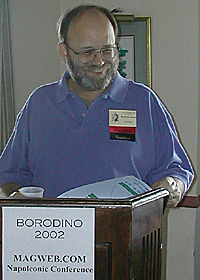 To judge by most rules, the Russian army during the Napoleonic wars was among the worst, but Chadwick maintains that the army was among the best. In terms of Borodino numbers, the total Russian army was around 75,000 versus the 85,000 French. Of note is that the French inflicted 45,000 casualties on the Russian army, but only captured about 900 prisoners and 20 guns. This meant that the Russian soldiers pretty much died in place. At the basic infantry level, it was a tough, hard-fighting army.
To judge by most rules, the Russian army during the Napoleonic wars was among the worst, but Chadwick maintains that the army was among the best. In terms of Borodino numbers, the total Russian army was around 75,000 versus the 85,000 French. Of note is that the French inflicted 45,000 casualties on the Russian army, but only captured about 900 prisoners and 20 guns. This meant that the Russian soldiers pretty much died in place. At the basic infantry level, it was a tough, hard-fighting army.
Organization
In 1810, the Russian infantry regiment had three battalions, of which each battalion had three line infantry companies, one elite jager light infantry company, and one elite Grenadier company. The first and third battalions followed this scheme while the second battalion served as a depot battalion.
A Russian Corps usually consisted of two divisions, each consisting of three infantry brigades (two Musketeer [line] and one Jager) and one artillery brigade. Each Infantry brigade consisted of two regiments (of two battalions each) while the artillery brigade had one "position" battery of 12 guns and two "light" batteries of 12 guns each.
At Borodino, the Russian Jagers are pulled out of the corps organization and deployed in front of the main army--in essense 1/3 of the army is in the forward detachment. The Russians were disappointed in the performance of the Jagers, but what can you expect when Jagers in skirmish formation went up against French close-order line? The light troops retreated, though it should be noted that they returned to their colors in the rear areas.
Were the grenadiers elite? In the early 1800s, the answer is no. They were chosen for their tall height, not necessarily for their battlefield prowess. In contrast, the Jagers were chosen for their small size. By 1810, the Grenadiers were receiving an influx of distinguished soldiers, somewhat mimicking the French Imperial Guard and becoming closer to elite troops. By 1812, they were as elite as their name represents.
The Grenadiers were pulled from their regular organizations into two divisions of 10 battalions each. The 1st Division was attached to the Russian Guard around the Shevadino redoubt and the 2nd were posted to the Bagration fleches. Both were tough and the second fought to virtual extinction. The 1st Division had two brigades, the first with 6 battalions and the 2nd with 4 battalions. The 2nd Division also had two brigades, the first with 4 battalions and the 2nd with 6 battalions.
The Life Guard Division was slightly different. It had three infantry brigades, the first two had the usual two regiments, but each regiment had three battalions because it took its depot battalion along on the march. The third brigade had one Jager regiment detached, leaving one regiment. The artillery brigade had two position and two light batteries. The division also included a second artillery brigade with two position batteries.
Opolchenie
These militia troops were part of the manpower available, but ill-equipped and more ill-trained. For example, the Moscow Opolchenie Corp had three divisions. The 1st Division had 1 Jager regiment and 3 Foot Cossack regiments. The 2nd Division had 3 Foot Cossack regiments. The 3rd Division had 2 Jager regiments and 2 Foot Cossack regiments. However, unlike the regular infantry, Opolchenie Jager regiments were not elite--the designation simply meant they were armed with muskets. The Foot Cossack regiments (each of four battalions) were armed with pikes--yes, that means good old fashioned pointy sticks.
They were used to guard prisoners and carry wounded--not carry out combat operations. Just prior to the battle, there was a rearrangement made placing them into various Corps. The III Corps, for example, deployed around Utitsa with 16 battalions: 6 jager and 10 Foot Cossack.
Cavalry
Prior to the Napoleonic wars, the Russian cavalry was not particularly good, but by 1812, had become a lot better. They did hold their own against the French and Allied cavalry during the Battle, with sharp counterattacks. Approximately 17,000 were at Borodino.
A Russian cavalry battalion consisted of 4 squadrons plus 1 depot squadron of about 100 men per squadron. Two battalions per regiment for light cavalry (Uhlans and Hussars) while one battalion per regiment for heavy cavalry (Cuirassiers).
 1st Cuirassier Division had 2 guard brigades and 3 line brigades plus 2 horse batteries (each of 12 guns). The 2nd Cuirassier Division had 5 line brigades. The Guard Cavalry Division had 3 dragoon and 3 light brigades plus 1 horse artillery battery. The 2nd Guard Cavalry Division had 2 dragoon and 2 light brigades plus 1 horse artillery battery. The 3rd Guard Cavalry Division had 2 dragoon and 4 light brigades plus 1 horse artillery battery. The 4th Guard Cavalry Division had 2 dragoon and 4 light brigades plus 1 horse artillery battery. All horse batteries were pulled from the Artillery Reserve and not instrinsic to the division.
1st Cuirassier Division had 2 guard brigades and 3 line brigades plus 2 horse batteries (each of 12 guns). The 2nd Cuirassier Division had 5 line brigades. The Guard Cavalry Division had 3 dragoon and 3 light brigades plus 1 horse artillery battery. The 2nd Guard Cavalry Division had 2 dragoon and 2 light brigades plus 1 horse artillery battery. The 3rd Guard Cavalry Division had 2 dragoon and 4 light brigades plus 1 horse artillery battery. The 4th Guard Cavalry Division had 2 dragoon and 4 light brigades plus 1 horse artillery battery. All horse batteries were pulled from the Artillery Reserve and not instrinsic to the division.
As for the Cossacks, 7,000 were at the Battle of Borodino, divided into three Corps: Vlasov (4 regts: 2000), Platov (6 regts plus one 2 bttn "Ottoman" regt and 3lber artillery battery: 3000), and Karpov (2000). A Cossack squadron was called a Sotnia, and Vlasov and Platov sotnias averaged 58 men while Karpov's sotnias averaged 50 men.
Artillery
Artillery batteries were made up of 12 guns spanning about 150 yards of frontage, or about 12 yards between guns. Two types: Position (12 pounder cannon and 20 pounder licorne) and Light/Horse (6 pounder cannon and 10 pounder licorne). Each battery consisted of 8 cannons and 4 licornes, with two licornes on each wing and the eight cannon in the middle. The Guard horse artillery only had 10 guns per battery. The two Cossack batteries contained 3 pounder guns.
The 1812 artillery was about the most advanced around with a screw elevation system, not the usual wedge system used by the French and others.
Once committed, the Russian artillery was difficult to move and still be effective, so the artillery commander, Kataisov, maintained a large reserve to be committed as needed. At Borodino, 621 guns in 52 1/2 batteries were available (the other 1/2 battery was lost at Shevadino redoubt), with 390 of them starting in the reserve. Note that most of these were soon moved to the front, for example, the position batteries sent to the Bagration fleches. Note that one criticism of this reserve system was that some guns remained all battle in the reserve because Kataisov was killed early on, and the Russian command structure could not handle such a high level loss. Indeed, such an Army-wide strategic reserve basically disappears with the death of Kataisov, to be replaced with corp-level reserves.
At the battle, "ear-witnesses" said they could not hear individual guns, but that it was one continuous roar of constant barrages. The Russians shot 30,000 rounds and the French between 40-50,000, which works out to 3 shot per second throughout the battle.
Chain of Command
The Russian chain of command was elongated with the addition of wing comanders, but the added layer seemed to work well. Kutusov was at the top as Commander in Chief, with two Wing Commanders underneath--Bagration and Barclay in the 1st and 2nd Armies of the West. Underneath them were the wing commanders--2 under the 1st Army of the West and 4 under the 2nd Army of the West.
Bagration and Barclay absolutely hated each other, and yet, because Kutusov's initial dispositions were so bad, they ended up working closely together for the good of the army and their country. Indeed, coordinated counterattacks, not exactly a Russian forte, were in evidence aplenty during the battle.
Summary
Far from the usual representations, the Russian Army is an outstanding army at the time of Borodino. Weak spots had been fixed and the leadership, especially during the battle, proved decisive and competent.
More Borodino 2002 Napoleonic Conference
- Welcome, Introduction, and the Hotel Chamberlain
Borodino Ballroom
MagWeb.com Napoleonic Speakers Conference
Friday Lecture: Bob Coggins: Napoleonic Unit Frontages and True Linear Scale
Friday Lecture: Frank Chadwick: The Russian Army at Borodino
Friday Lecture: Jean Lochet: Preparation of French Cavalry for Campaign of 1812
Friday Tour: Fort Monroe Casemate Museum
Friday Keynote Lecture: Dr. William J. Gregor: Long Shadow of Napoleon on American Military Planning
Friday Lecture: Jean Lochet: The Attempt to Rebuild the French Cavalry for 1813
Saturday Lecture: Kevin Zucker: The French Army of 1812
Saturday Lecture: Dr. James H. Birdseye: Glory or Shame? The Role of Morale on the Napleonic Battlefield
Saturday Lecture: Dr. George Nafziger: Prelude to 1812: The 1809 Campaign in Poland
Special Guest: Lt. Col. Andrey Pavlov: Deputy Military Attache from the Russian Embassy
Saturday Lecture: Glenn Drover: Napoleonic Game Design and Production
Saturday Lecture: Jean Lochet: The Peace Conference of Prague: Negotiations with Napoleon During the 1813 Armistice
Video Presentation: Dr. Ben Weider: Borodino Re-enactment 1997
Video Presentation: Austerlitz and Sharpe
Re-enactor Presentations: Russians and French
Borodino: The Wargame
Side Wargames: Survivor, et al.
Awards Banquet
Back to List of Conventions
Back to Travel Master List
Back to MagWeb Master List of Magazines
© Copyright 2002 by Coalition Web, Inc.
This article appears in MagWeb (Magazine Web) on the Internet World Wide Web.
Other military history articles and gaming articles are available at http://www.magweb.com